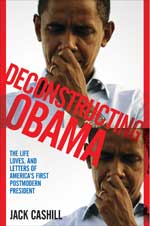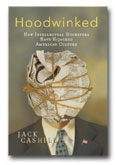Team Trayvon's Big Lie
Get your copy of Deconstructing Obama

___
Jack Cashill's book:
Hoodwinked: How Intellectual Hucksters have Hijacked American Culture

Click here for signed first edition
©Jack Cashill
AmericanThinker.com - May 13, 2013
While watching George Zimmerman's immunity hearing online in late April 2013, Chip Bennett took satisfaction seeing Florida prosecutor Bernie de la Rionda flail away at the one blog that has given him fits from the beginning. "BDLR alleges that The Conservative Treehouse doxed Witness 8," Bennett commented. "Double shot!"
By "Double shot," Bennett meant "doubly cool." This was the second of three occasions on which de la Rionda would refer to the Treehouse. By "doxed" he meant, in a word, "outed." More comprehensively, the Urban Dictionary defines "doxing" as "a technique of tracing someone or gathering information about an individual using sources on the internet." The word likely derives from the Microsoft Word format "Docx."
In fact, doxing succinctly describes how a blogging collective like the Conservative Treehouse works. What troubled de la Rionda is what troubles many authority figures: doxing levels the media playing field. He and they could no longer control the narrative by feeding information to compliant media sources. De la Rionda worried too that the Zimmerman defense was taking its cues from the relentless doxing done by the Treehouse as though that somehow gave the defense an unfair advantage. For the record, the Treepers have refused to communicate with the Zimmerman defense lest they be accused of doing what de la Riona insinuated.
Bennett had been following Zimmerman's travails from the beginning and commenting on the Treehouse since June 2012. A chemical engineer by profession and a logician by avocation, the 35-year-old Bennett believes "one hundred percent of the evidence in discovery supports Zimmerman. I don't think there's been a single bit of evidence that convicts." As the June trial approaches, he strongly believes that Zimmerman will be acquitted. On this point, he has more faith in the judicial system than many of his Treehouse colleagues.
Like all the "Treepers," though, he has real problems with witness #8, the elusive "Dee Dee," the girl who had been on the phone with Trayvon Martin in the moments leading up to his shooting by Zimmerman in Sanford, Florida, on February 26, 2012. This mystery witness remained unknown even to Team Trayvon, the legal/PR machine headed by Martin family attorney Benjamin Crump, until March 18, 2012. Instead of contacting the police after discovering her, Crump contacted ABC's always pliable Matt Gutman. Gutman was uniquely allowed to listen to a phone interview with Dee Dee on March 19 but not ask questions.
The following morning, March 20, ABC ran an exclusive preview of what was to come later that day, which included footage of Gutman listening to the conversation. At a lunchtime press conference, Crump shared what he learned. CNN, among others, covered the press conference live. As studio anchor Kyra Phillips waited for the conference to begin, she enthused about the "chilling new perspective" added to the case by the testimony of this heartsick girl who was on the phone with Martin when he was shot.
Phillips then introduced CNN legal analyst Sunny Hostin. Hostin had spoken with Crump earlier and shared with the CNN audience exactly what Crump hoped he would share. "Trayvon Martin told his friend that someone was following him," said Hostin. "He was nervous. He was concerned. She explained to him that he should run. He told her he was not going to run, but he was going to walk quickly in an effort to get away from the person that he thought was pursuing him."Hostin summarized that this "was the last conversation that Martin had with anyone, and it also, in my view, dispels the notion of self-defense."
A few minutes later, Phillips cut to the press conference. As Crump told the story, the young couple had been on the phone for an astonishing 400 minutes that day, caught up as they were in "puppy love." So distraught was Dee Dee at Martin's death, said Crump, "She couldn't even go to his wake she was so sick. Her mother had to take her to the hospital. She spent the night in the hospital." Lest the media try to exploit this romance, Crump asked them to "please respect her privacy. She is a minor." As would be proven later, Dee Dee was neither hospitalized nor a minor, but those were the least of the day's lies.
The extended phone calls included the time Martin walked to the neighborhood 7-11 and returned. According to Dee Dee, it started raining hard so Martin looked for shelter. It was then that Martin noticed that a man was "following him." Dee Dee told him, according to Crump, "Be careful. Just run home." At this point in Dee Dee's account, Zimmerman left the truck and pursued Martin, who could not quite seem to shake him. Dee Dee also provided a handwritten summary of her call with Martin. This version of Martin's final minutes is clearer than what is heard on the phone call.
[Martin] started walking then noticed someone was following him. Then he decided to find a shortcut cause the man wouldn't follow him. Then he said the man didn't follow him again. Then he looked back and saw the man again. The man started getting closer. Then Trevon (sic) turned around and said why are you following me!
Lest the media rely only on his word, Crump played at least segments of the actual recording for the press. Its climactic scene as described by Dee Dee was recorded as follows:
He said this man was watching him so he put his hoodie on, Trayvon said.
"What you following me for?" The man said, "What you doin' around here?"
Then somebody pushed Trayvon because the headset just fell.
"She connects the dots," Crump told the media excitedly. "She completely blows Zimmerman's absurd defense claim out of the water." According to Crump, the heavy-set, twenty-eight year old "loose cannon" had no intention of going back to his truck. He pursued Martin and shot him down. Dee Dee heard it all. The witnesses confirmed her testimony. Cried the outraged Crump at the end of his presentation, "Arrest George Zimmerman for the killing of Trayvon Martin in cold blood today."
Crump got his point across. Gutman headlined his piece on ABC.com, "Trayvon Martin's Last Phone Call Triggers Demand for Arrest Right Now." ABC's Diane Sawyer introduced Gutman's TV piece, which hammered the Sanford Police Department for its many presumed failings, by referring to Zimmerman as the "neighborhood watchdog." The piece closed with a photo of a young Martin hugging a baby.
In none of the contemporary reporting did anyone challenge Crump's account. No one asked why this girl failed to inquire about the fate of her beau who, when last heard from, was getting beaten by an unknown man. Why did she not call Trayvon's parents? Why did she not call the police after she learned of his death? How could the plodding overweight Zimmerman have run down the younger, fitter Martin?
These, however, were minor journalistic oversights compared to the most damning oversight of all: the failure to confirm who was crying out for help. At this stage, the media had full access to the 911 calls from the eyewitnesses. On the 911 call from Witness #11 one hears in the background forty-two seconds of screaming. The man on the tape yells "help" over and over. No one could deny the fear and desperation in his voice. The case hinged on that discovery, and yet not a single major media commentator thought to question Crump's concocted analysis of the screams.
"Logically, it makes sense that Trayvon Martin was the voice you heard crying on that tape," Crump insisted at the press conference. As to why those screams should be Martin's, Crump would have been better off saying nothing. Instead, he volunteered in his reliably mangled syntax, "You can conclude who is the person crying out for help presumably when they see a gun."
Crump wanted the media to believe that Zimmerman chased Martin down, held him at gunpoint, caused him to wail like a banshee for forty-two seconds at the sight of the gun, and then shot him down in cold blood knowing the police -- whom he himself had summoned -- were minutes away.
If that were not enough, Witness #6, the best of the eyewitnesses, had talked on camera to the local TV station the day after the shooting and told the reporter what he told the Sanford PD the night before, namely that a there was a "black man in a black hoodie on top of either a white guy . . . or an Hispanic guy in a red sweater on the ground yelling out help," and that black man on top was "throwing down blows on the guy MMA [mixed martial arts] style."
There was no excuse for the media not to incorporate this account into their reporting and not to connect it to Zimmerman's broken nose and bloodied head, but in the hysterical month of March 2012, the media were much too eager to convict the "white Hispanic" Zimmerman of an imagined hate crime to quibble with something as pedestrian as the truth.
Jack Cashill's book on this case, "If I Had a Son," will be published soon after the trial.
Webmaster's Note: Jack Cashill's Book-TV presentation of "Deconstructing Obama" can be viewed at http://www.c-spanvideo.org/program/298382-1
Editor's note: For a more complete account of this phenomenon, read Jack Cashill's amazing book, "Hoodwinked: How Intellectual Hucksters Have Hijacked American Culture.

